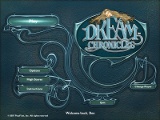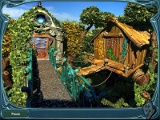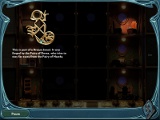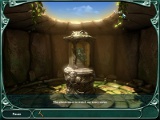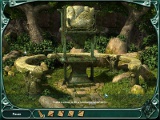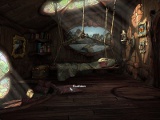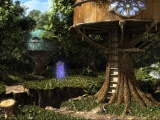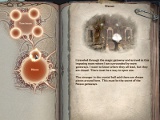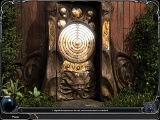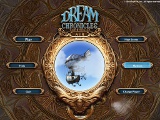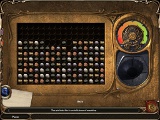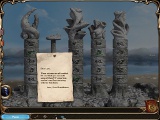





The Count of Monte Cristo (demo)
While I like having games on CD rather than as downloads, the supermarket
games found it necessary to install demos of other games. One of these was the
Dutch version (spelling and vocabulary errors guaranteed) of the game adaptation
of this famous novel. What did I see in the 60 minutes playing time: a crudely
drawn comic telling me about the implication of Edmond Dantes in some plot, and
his subsequent arrest. Eight suspects to "question" by finding objects in
various scenes on land and on the sea, with five hints per person. The graphics
have the right historical and yet slightly bizarre feel to them. Some locations
need a key which I am told to find in a dark cave, where I can also search for
gems to get more hints. Between searches, there are various interim games,
including samegames.
I've tried out the English demo to get some screencaps, and while the higher
resolution suggests this game is not as vintage as I thought it was, it still
has the problem of vintage games; a slightly fuzzy appearance that makes it
harder to identify what I'm looking at. The game is no longer on the Oberon
(now CasualGames.com) website, but still available from
Big Fish Games, as well as its sequel,
The Return of Monte Cristo.
Insider Tales:
The first of these games was installed as a demo, translated in Dutch, with
no glaring translation errors that I can remember. I liked it and, seeing a
second title in the Insider Tales series, hoped the two would be offered as a
bundle. This hasn't happened, because this second title was in fact the third
title, judging from the "2" inserted in the title of yet another game in the
series. So, seeing them at a discount in mid-2012, and fearful they would soon
disappear off the site, I bought all three separately.
(Two years later, I find all three in the Insider Tales Triple Pack at
GameHouse. Sigh.)
In The Secret of Casanova, police officer (and eye-candy
female, who will come into view after every solved puzzle) Francesca di Porta is
on holiday, but when professor Manini phones her to say he found a valuable
relic in Tuscany and needs her help, she jumps on the first plane to Milan. The
office is empty: the professor has already left, confident that she will know
what to do based on the clues he left her. And so the game starts, with a simple
hidden objects screen. Here I already notice something unusual: the names of
objects to find are in two columns, moving up as each object is found and its
name disappears to make way for another, but the columns are independent, so if
I've found everything in the right column, it is now empty while the left column
won't budge. Since objects on the list can't be found until their names appear,
this slows down searching a bit.
But after the regular hidden object search, the problems begin. I'm supposed
to get a book from a locked bookcase. Um, how? I wildly move the cursor about.
Hey, it changes into a magnifying glass with an eye in it over that map there.
Let's click on it. It changes into a revolving tile puzzle. Solving this
produces the bookcase key. Now the book is taken out and I have to use that to
find the key to open the safe to find the diary of Casanova. Phew. Professor
Manini may have confidence in Francesca to solve his riddles, but he's
overestimating me. It's lucky that there is a huge, lens-shaped self-recharging
hint button and no timer, and that too many wrong clicks do nothing worse than
making the cursor somersault. Anyway, I solve a riddle by Casanova, who is even
more of a riddler than Manini - excerpts from his diary will continue to be
unhelpful along the way - and finally the diary opens to reveal a heart-shaped
hole and four pop-up models of the big cities that represent the four forces in
his life: Paris, Vienna, Venice and Prague. From each city, Detective di Porta
must retrieve a piece of his shattered heart amulet and return it to the diary,
to find the fifth force that healed his heart.
Each city has its own background music and its own theme. When I find an
object, little signs swirl around it: four-leaf clovers for Paris, treble clefs
for Vienna. The discovery of a heart piece is accompanied by harp music. Interim
games don't so much alternate with search screens as follow logically from them,
and more than once I have to search by moving a light or lens over the scene to
show up what I'm looking for. When I first played the demo, I had seen very few
hidden object games yet, and so was deeply impressed by both the art and the
story, which is quite original - having to assemble a breakfast for a security
guard, repair a telescope and adorn a statue to match a picture in Casanova's
supposed diary - although I suspect its ending is not historically correct. Now,
finally having bought the game and played it out to its end, I must say it's too
short. Especially Prague is a city I hate to leave, and I would have liked a few
more hours' worth of puzzles to delay my departure.
Having replayed it, I found it was exactly the same the second time round, so
the only replay value is in enjoying the sights and the sometimes mesmerizing
background music.
I'm not sure whether Insider Tales 2: The Stolen Venus is
adapted to modern wide-screen resolutions: on the one hand it has a wide screen,
on the other hand, when I quit and return to the desktop, I see the warning
about the screen resolution being too low that's usually shown after playing
older games. The screen itself appears designed for the old 1024x768 resolution,
with curtains filling space on the sides so the game doesn't look letterboxed.
Other signs that this game is newer and more technologically advanced than its
predecessor is the moving bits of scenery and the fact that some screens scroll
from left to right. Fortunately, it is not voiced.
Starting with a simple menu that basically says "play, options, quit" (to
manage player profiles, click on the button that says "if you are not this
player, click here") in a harbour setting with squawking gulls, it gives a slide
show of what happened before: aboard a cruise ship, a sculpture modelled after
Botticelli's Venus has been stolen, and would officer Francesca di Porta please
find and return it before anyone notices? The background music is halfway
between exhilarating and leisurely, a whodunnit with a holiday feel, and indeed
Francesca remarks that she hopes to solve the crime as quickly as possible so
she can get back to vacationing.
Like the previous game, this one has a self-recharging hint button and no
timer; and it is not for beginners. Like the Dream Chronicles below, the
Insider Tales are mostly puzzles with some hidden object screens, and as
a veteran player of such games, I usually instantly recognized what was expected
of me: match rings/keys/names, arrange knots, match pairs (where the two halves
of the pair are not always identical), drag and rotate puzzle pieces so they fit
together, play slide games or swap tiles. But sometimes I didn't have a clue,
and the hint button didn't always help. Rather than receiving instructions, I
have to move the cursor over the screen until it changes shape as an indication
that something needs to be done in that spot, but after completing part of a
puzzle, the cursor may not react any more, and I may have to leave and re-enter
the screen to continue. There are real bugs in the game, too; a glass shard went
missing when I had to reassemble a glass circle (but fortunately the hint button
allowed me to skip that puzzle) and when I went to the pizza-making space
without a bowl of dough and picked up the spoon, I couldn't put it down or leave
the screen (I had to delete that player profile and start over). In addition,
the English is a bit iffy; the thief has broken up the sculpture into its
component parts, ie. ceramic, metal and precious stones, which Francesca guesses
by observing that the sculpture is "made of treasure". One improvement on the
previous game is the "case book", showing the investigation's progress, and fun
to read while waiting for the hint button to recharge.
Another improvement is that the game is not exactly the same upon replay,
that is to say, the lists for hidden object screens vary slightly. Things like
safe combination codes are the same every time, but I can't just skip ahead and
open the safe, because every part of the puzzle has to be completed in the right
order. This game again feels too short, as she only investigates the ship and
the two locations where the passengers did some sight-seeing, but boy oh boy are
there some sights to see: the fountain with zodiac sign heads, the sumptous
restaurant with its stonewashing sinks, the forest and tumbledown chapel lit up
by the sun.
The opening screen of Vanished in Rome is much like the
second, only the pillar with the menu buttons on it revolves to show more
buttons, and there is a "Profiles" button. After the widescreen experiment, the
resolution is back to narrow, the "case book" is gone, the game again plays
identically every time (except for the lock and chimes minigames), which, with
the less opulent graphics, suggests that it is older than The Stolen
Venus; only the fact that its characters refer back to this case establishes
its position as the third in the series. It does share some features with the
second game: the side-scrolling screen, the bits of animated scenery, and of
course the frequent puzzles, self-recharging hint button and lack of a timer
common to all three games. As subtle improvements, the screen can now also "zoom
in" - like the side-scrolling, but this time backwards and forwards; a variation
of the search screen has been added where the player has to find and
"photograph" selected bits of scenery, and Francesca's lips wobble when she
talks; but happily, the game is unvoiced.
The plot for this game is that an Italian couple who won the jackpot has
disappeared without claiming the prize, and it's up to Inspector di Porta to
find them; but of course this wouldn't be an Insider's Tale if there wasn't art
involved. The game includes almost every type of puzzle/minigame out there -
concentric circles, pipegames, slide games, mirror games, and whatever they are,
I'm always effusively praised for solving them - yet still manages to feel way
too short, surprising me, like the previous games, with a happy ending when I
was just getting into it. In this case, the "happy" ending is that the couple
donates the prize to charity so that the mafia, who they were hiding from, won't
get their hands on it, and an artifact is unearthed. The language is not quite
as stilted as in the previous game, although there are still some funny terms in
the search screens: "brandy snifter" for a brandy glass and "hand brush" for a
set of dustpan and brush, as well as singulars that should be plurals and vice
versa. The game is really not bad, but, compared to the visual splendour of the
first two, slightly disappointing.
The Dream Chronicles:
Note: after uninstalling Adobe's Flash Player on my
computer because it kept whining about updates but didn't update itself
properly, I found that Dream Chronicles 2 and higher need it to run.
Specifically, they need the ActiveX component for Internet Explorer, not the
plugin for Firefox and other browsers. I installed both separately; this also
seemed to solve the update problem.
The Dream Chronicles games have the following formula: a woman wakes in a
dream-like state. Someone has cast a sleep spell on the world and the woman has
to put things right while walking around in surreal surroundings. There are also
dream jewels to complete, by collecting the gemstones that fell out of them;
through the succession of games, these become progressively less significant.
My first Dream Chronicles game was Dream Chronicles 2: The Eternal
Maze from Acer's Goodie Bag Bundle - 3 in 1, and because I thought
the other goodies in the bag weren't all that good, this one was paid for last.
When I redeemed the 3-in-1 bundle that contained this second game, I saw that a
Dream Chronicles bundle containing the first three games had been released.
Argh! Now I have three game icons instead of one, and two extra games that I
don't like. It was a search for the other Dream Chronicles, though, that
prompted me to become a platinum member of the Oberon Media site, since it had
all the games in the series. Not quite a hidden object game, The Eternal
Maze struck me as a graphical version of a text adventure, with lots of
little puzzles to solve, and, of course, graphics, lovely graphics. Dream-like
graphics. A perfect game for anyone who wants to escape from grim reality.
The first game is essential to understanding what's going on in
the other games, though not to enjoying them. It is easy, as despite the absence
of hints, if there is no mouse activity for a while, the next findable or
otherwise clickable object will start to twinkle. The ironically named Faye
wakes one day to find her husband gone. She doesn't know that her husband,
bearing the manly name of Fidget (his own father is called Tangle) is - that's
what makes her name ironic - a fairy. Not only has Fidget disappeared, but their
infant daughter Lyra is fast asleep and won't wake up. The cause of this:
Lilith, Fairy Queen of Dreams, who has come to collect the man promised to her
in marriage, only his parents decided that he should be allowed to choose for
himself, and he married a human instead. Fidget, who feared the day would come
that Lilith would abduct him, has left Faye a diary of sorts to help her find
him. While she finds ways to get into her daughter's room, her inlaws' house,
and finally Lilith's domain, she must also collect the pieces that have fallen
out of the dream jewels Lilith has stolen. These are not important to the game,
but the percentage of completed dream jewels is part of the high score. As each
piece is clicked on, a sometimes humorous message appears to say what fairy made
this stone. The fairy family is a very extended one, and the departure of Tangle
and Aeval - king and queen of the fairy realm, no less - has caused such
upheaval in their world that Lilith feels she is only doing the right thing in
collecting her husband to restore order. Even allowing for the fact that this is
supposed to be a dream, Faye's own human village called Wish looks like
something straight out of a fairy tale, making the line between human and fairy
very thin indeed. The game ends on a cliffhanger, as Faye arrives at Lilith's
mansion only to see a dim outline of her beloved Fidget before he is whisked
away again.
The second game starts in the "prison" (limestone pit with
greenery) that Lilith has sent Faye to. Aeval, her mother-in-law, speaks to her
through the plants, promising to guide her and urging her to hurry before Fidget
loses hope and marries Lilith, although the scenery is so pretty and the
background music so soothing that I'm tempted to linger. Some puzzles and two
dream jewels later, Faye is in the musty maze that the game is named after, to
return to the mortal world, find a scientist-turned-plant called Merrow, and go
to the Tower of Dreams where her husband is kept, and possibly her child, who,
Aeval reports, has been whisked away also. This time I have to pick up not only
the precious stones, but also the dream jewels they are set in; there are eight,
much less than in the first game, but they do contribute to the score, and each
completed dream jewel gives a hint. Some dream jewels vary per game, so in one
game I start with a snail, and in another, with a lizard. Completed dream jewels
also let me piece together some fairy lore, one of them foreshadowing the next
game by telling me that Lyra may be the Chosen Child. After more puzzles,
including the gathering of instruments and musical scores for a little concerto,
Faye finds Fidget, but Lyra remains missing.
The third game again completely switches scene: Brennan, a
dedicated seamstress who keeps a dream journal, lives happily in an absolutely
magnificent tree house. Until, one day, the image of Fidget appears to her via a
crystal ball. Finally, I get a look at this husband of hers to see if he's worth
all that trouble, because, really, I would have difficulty leaving that tree
house to go back to my old life. Brennan is guided by notes left in various
places to the nexus, a place from where she can teleport to various locations,
like the herbalist's house where she can brew a potion to restore her memory.
(Warning: collecting items ahead of time here means not being able to find vital
items later.) The dream jewels play a part in this: it is by arranging them on
the nexus control panel that the player can access new locations. They are also
quite prettily designed! Part of the game is finding a way to forge new jewels.
Thanks to the nexus, the game goes all over the place and ends in the underwater
fairy retreat where a pregnant Lilith is resting, and where I play the organ
more than is necessary. Since for once she is not the villain of the story, she
gives Brennan/Faye the last bit of information needed to finish the game.
The Book of Air starts with an intro showing images from
previous games. It is Lyra's 18th birthday, but just as she is about to receive
a present from her grandfather, surrounded by birthday guests, she is
transported to a deserted dream version of her village, Wish, and the box
granddad had meant to give to her plops down out of thin air. (Anyone who has
played the third game knows who's behind this.) It is up to her, like her mother
before her, to solve all the puzzles, aided by her grandfather's notes and, this
time, an actual hint button. To start with, she must break into the school, do
some deciphering, and find a way to the ornate airship (hence the title) that
her father made. This airship is shown in the game menu, with sounds of stones
grinding together as concentric circles revolve around it. Then, she must find
the Keeper of Time, and travel to three areas to find three keys. On her
triumphant return, she sees dark clouds gathering over Wish: this is another
cliffhanger. The ship is, amusingly, fuelled by a session of SameGame with
pebbles, and the dream jewels are mere colourless shards of diamond that will
activate a new power if enough of them are collected. Being a newer game, this
one sadly has voiceovers, although they are bearable to listen to. I keep the
sound on at any rate so I can hear the fairy tune once Lyra has remade the
musical scores. As she says: beautiful music. The game can be played in hard and
simple mode, but the final brain-breaking puzzle at the end (even if only
because I don't know what to do with these heads and chalices) is the same for
both. Hint: find the plank combination that goes with each decorative bit of
metal, and place on wood accordingly.
Although the Insider Tales were bought so much later than
the initial install of the demo, I moved the later titles up into the list to
keep the three together. I won't be doing the same for later Dream Chronicles,
because that series is still producing sequels. So, the next game, The Book of Water, can be found on page 8.
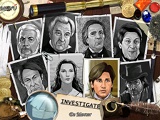
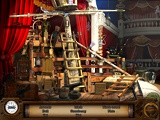
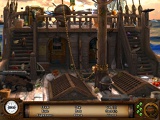
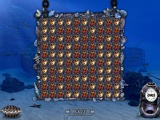
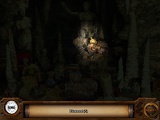
Insider Tales: The Secret of Casanova
Insider Tales 2: The Stolen Venus
Insider Tales: Vanished in Rome

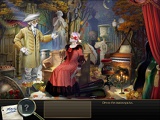

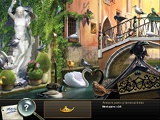
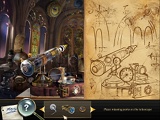
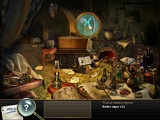
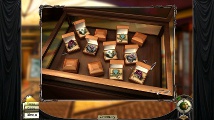
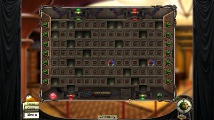

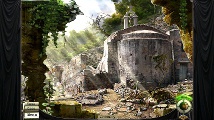
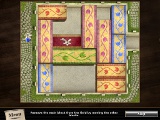
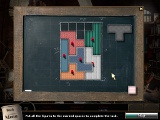
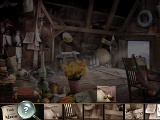
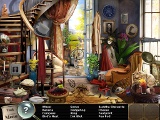
Dream Chronicles
Dream Chronicles 2: The Eternal Maze from Goodie
Bag Bundle - 3 in 1
Dream Chronicles 3: The Chosen Child
Dream Chronicles: The Book of Air Standard Edition
(makes me wonder what the non-standard edition is)
